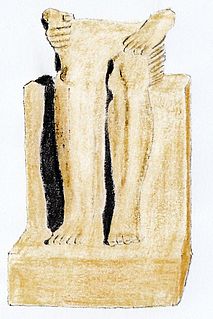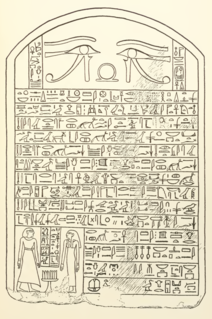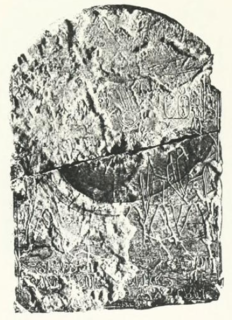
| Ibiaw [1] | ||||
|---|---|---|---|---|
| Era: 2nd Intermediate Period (1650–1550 BC) | ||||
| Egyptian hieroglyphs |
Ibiaw or Ibiau was an ancient Egyptian vizier and Chief of the town (i.e. mayor) during the 13th Dynasty, likely under pharaohs Wahibre Ibiaw and/or Merneferre Ay.

| Ibiaw [1] | ||||
|---|---|---|---|---|
| Era: 2nd Intermediate Period (1650–1550 BC) | ||||
| Egyptian hieroglyphs |
Ibiaw or Ibiau was an ancient Egyptian vizier and Chief of the town (i.e. mayor) during the 13th Dynasty, likely under pharaohs Wahibre Ibiaw and/or Merneferre Ay.
There are no monuments which directly represent him, but he is mentioned as a vizier on three objects: a stele found at Deir el-Bahari and now exhibited in the Metropolitan Museum of Art (22.3.307), another stele found inside the sanctuary of Heqaib at Elephantine, [2] and a statuette probably from the Temple of Osiris at Abydos and now in Bologna (KS 1839). By combining the three monuments, egyptologists were able to realize a genealogy for Ibiaw:
| Id | |||||||||||||||||||||||||||||||||||||||
| Ankhesiref | Ibiaw | Renressonb | |||||||||||||||||||||||||||||||||||||
| Senebhenaf A | Senebhenaf B | Ibetib | |||||||||||||||||||||||||||||||||||||
Some other monuments datable to this period refer to one or more dignitaries called Ibiaw. Some egyptologists believe that those objects could refer to the namesake vizier in some earlier stages of his career. Such statements would expand Ibiaw's genealogy:
However, Wolfram Grajetzki later pointed out that, since there is no monument citing with certainty some of Ibiaw's earlier titles, such identifications are purely conjectural and remain unproven. [6]

Merneferre Ay was an ancient Egyptian pharaoh of the mid 13th Dynasty. The longest reigning pharaoh of the 13th Dynasty, he ruled a likely fragmented Egypt for over 23 years in the early to mid 17th century BC. A pyramidion bearing his name shows that he possibly completed a pyramid, probably located in the necropolis of Memphis.

The Middle Kingdom of Egypt is the period in the history of ancient Egypt following a period of political division known as the First Intermediate Period. The Middle Kingdom lasted from approximately 2040 to 1782 BC, stretching from the reunification of Egypt under the reign of Mentuhotep II in the Eleventh Dynasty to the end of the Twelfth Dynasty. The kings of the Eleventh Dynasty ruled from Thebes and the kings of the Twelfth Dynasty ruled from el-Lisht.

Huni was an ancient Egyptian king and the last pharaoh of the Third Dynasty of Egypt during the Old Kingdom period. Following the Turin king list, he is commonly credited with a reign of 24 years, ending c. 2613 BC.

Mentuhotep I may have been a Theban nomarch and independent ruler of Upper Egypt during the early First Intermediate Period. Alternatively, Mentuhotep I may be a fictional figure created during the later Eleventh Dynasty, which rose to prominence under Intef II and Mentuhotep II, playing the role of a founding father.

Amenemhat I, also known as Amenemhet I, was a pharaoh of ancient Egypt and the first king of the Twelfth Dynasty of the Middle Kingdom.

Senusret I also anglicized as Sesostris I and Senwosret I, was the second pharaoh of the Twelfth Dynasty of Egypt. He ruled from 1971 BC to 1926 BC, and was one of the most powerful kings of this Dynasty. He was the son of Amenemhat I. Senusret I was known by his prenomen, Kheperkare, which means "the Ka of Re is created." He expanded Egypt that allowed him to rule over an age of prosperity.

The Thirteenth Dynasty of ancient Egypt is often combined with Dynasties XI, XII and XIV under the group title Middle Kingdom. Some writers separate it from these dynasties and join it to Dynasties XIV through XVII as part of the Second Intermediate Period. Dynasty XIII lasted from approximately 1803 BC until approximately 1649 BC, i.e. for 154 years.

Khasekhemre Neferhotep I was an Egyptian pharaoh of the mid Thirteenth Dynasty ruling in the second half of the 18th century BC during a time referred to as the late Middle Kingdom or early Second Intermediate Period, depending on the scholar. One of the best attested rulers of the 13th Dynasty, Neferhotep I reigned for 11 years.

Khaneferre Sobekhotep IV was one of the more powerful Egyptian kings of the 13th Dynasty, who reigned at least eight years. His brothers, Neferhotep I and Sihathor, were his predecessors on the throne, the latter having only ruled as coregent for a few months.

Wahibre Ibiau was an ancient Egyptian pharaoh of the 13th Dynasty, who reigned c. 1670 BC for 10 years 8 months and 29 days according to the Turin King List.

Labib Habachi was an influential Coptic Egyptian Egyptologist.

Ankhu was an Egyptian vizier of the early 13th Dynasty, who lived around 1750 BC.
Senebhenaf was an ancient Egyptian vizier during the Second Intermediate Period.

Djedneferre Dedumose II was a native ancient Egyptian pharaoh during the Second Intermediate Period. According to egyptologists Kim Ryholt and Darrell Baker, he was a ruler of the Theban 16th Dynasty. Alternatively, Jürgen von Beckerath, Thomas Schneider and Detlef Franke see him as a king of the 13th Dynasty.

Sekhemre Sementawy Djehuti was possibly the second king of the Theban 16th Dynasty reigning over parts of Upper Egypt during the Second Intermediate Period. Alternatively, he may be a king of the late 13th Dynasty or the fourth king of the 17th Dynasty. Djehuty is credited with a reign of 3 years in the first entry of the 11th column of the Turin canon. According to Egyptologists Kim Ryholt and Darrell Baker, he was succeeded by Sobekhotep VIII.
Detlef Franke was a German Egyptologist specialist of the Middle Kingdom of Egypt.

Heqaib, also Hekaib or Hekayeb, was an ancient Egyptian nomarch of the 1st nomos of Upper Egypt under king Pepi II Neferkare, towards the end of the 6th Dynasty. He was also an officer in charge of military expeditions in Nubia.

The Bust of Amenemhat V is a sculpture showing the head of the ancient Egyptian king Amenemhat V, who ruled at the beginning of the Thirteenth Dynasty. One of the major art works of this period, it is today in the Kunsthistorisches Museum in Vienna with the inventory number ÄS 37.

Sarenput I was an ancient Egyptian official during the reign of pharaoh Senusret I of the 12th Dynasty.
The Temple of Satet or Satis was an ancient Egyptian temple dedicated to the goddess Satet, a personification of the Nile inundation. The temple was located on the Nile Valley island of Elephantine, Egypt. Founded during the late Predynastic Period around 3200 BC, it was enlarged and renovated several times from the Early Dynastic Period onwards over the next 3000 years until the Ptolemaic Period. The temple of Satet is the best example of an ancient Egyptian temple whose construction is attested over the entire pharaonic period.